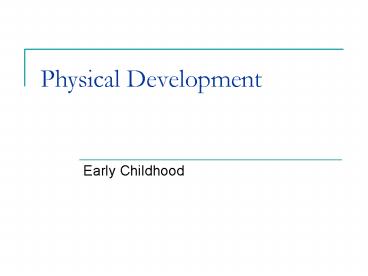Physical Development - PowerPoint PPT Presentation
Title:
Physical Development
Description:
Physical Development Early Childhood BODY GROWTH 2 to 3 inches (6-7cm) in height and about 5 pounds (2-3kg) in weight are added each year. Children become thinner. – PowerPoint PPT presentation
Number of Views:214
Avg rating:3.0/5.0
Title: Physical Development
1
Physical Development
- Early Childhood
2
BODY GROWTH
- 2 to 3 inches (6-7cm) in height and about 5
pounds (2-3kg) in weight are added each year. - Children become thinner.
- Children lose primary teeth by preschool years.
3
Asynchronies in Physical Growth
- General growth curve
- Rapid growth during infancy
- Slower middle childhood
- Rapid during adolescence
- Exceptions Reproductive and lymph systems
4
BRAIN DEVELOPMENT
- The brain increases to 90 percent of adult weight
between 2 and 6 years. - Increase in synaptic connections
- Increase in myelination
- The two hemispheres of the cortex develop at
different rates. - The left hemisphere shows dramatic activity
between 3 and 6 years and then levels off. WHY? - Activity in the right hemisphere increases slowly
throughout early and middle childhood. - Significant development occurs in the prefrontal
cortex
5
Nutrition
- Slowed growth leads to an appetite decrease
- Picky eaters seen as adaptive,safe
- Need a high-quality diet
- By 7, low-SES about 1 inch shorter
6
Childhood Injuries
- Accidents are the leading cause of childhood
mortality. - Auto, fires, and drowning are the most common.
- Motor vehicle collisions first cause of death for
children over 1
Injury Mortality for Children
7
MOTOR DEVELOPMENT
- Gross Motor Development
- Center of gravity shifts downward to the trunk,
and balance improves. - Preschooler's gait becomes smooth and rhythmic.
- Now steadier
- New skills like throwing and catching balls,
tricycles, and swinging on bars and rings - High level of activity
8
Fine Motor Development
- Self-Help Skills
- Gradually become self-sufficient at dressing and
feeding - Shoe-tying around age 6
- Drawing and Writing
- First drawings of a person by age 3 or 4
9
Cultural Variations in Drawing
- In cultures that emphasize art, children's
drawings are more sophisticated. - Schooling supports drawing.
- Figure drawing varies by culture but follows the
same sequence.
U.S. Childs Drawing
New Guinea Childs Drawing
10
Printing
- Exposure to lines and shapes leads to trying to
print letters and, later on, words. - Not until reading do kids distinguish between
mirror-image forms.

